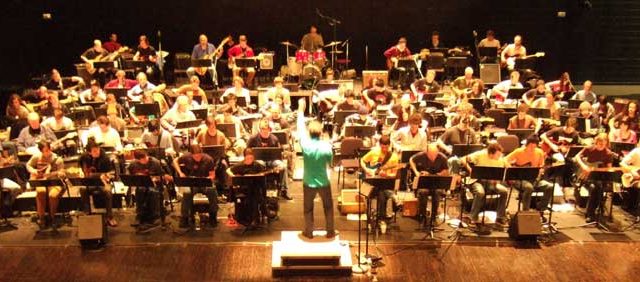Glenn Branca, who died Sunday of throat cancer at the age of 69, took one of the most unlikely and necessary journeys in 20th century music. Coming out of the punk movement of 1970s and 80s New York, so devoted to stripping rock down to its essentials in materials and time, Branca took the former–the guitars, the drums, the chords–and used a rigorous, almost mathematical approach to build massive structures over time. Rock musicians have a difficult time in the classical realm because they rarely have the skills to construct past three or four minutes (Peter Gabriel, I love you man, but I am side-eyeing in your direction); Branca was an exception, constructing truly monumental works in time and volume. His final oeuvre counts sixteen symphonies, and all of them deserve the name.
He began as a guitarist in the bands the Static and Theoretical Girls, and moved from there to Steve Reich-like experiments with repeating electric guitars. A work like Lesson #1 comes across as a hybrid of New Order’s “Elegia” and Reich’s phasing works:
This was a structure Branca would return to, over and over: simple materials built up through repetition and interlocking to something overwhelming. He quickly moved from the instrumentation of rock ensembles to industrial materials: his First Symphony features 2x4s hitting oil drums, the Second has Andrew Z’ev Weinstein’s arrays of metallic percussion.
With the Third Symphony, Branca began to craft his own instruments, electric keyboard-guitars that look a little like harpsichords. Subtitled Gloria: Music for the First 127 Intervals of the Harmonic Series, the Third is exactly that: Branca abandoned the 12-note scale of Western music for something literally fundamental, where every note is an integer multiple of one fundamental frequency, 1x, 2x, 3x, all the way to 128x. The first movement builds off the numbers, as the harmonic space gradually gets more and more filled, until the air itself feels like it will burst into noise:
Audio PlayerHe kept exploring this throughout his life, moving from these ensembles back to ordinary guitars, to orchestras, to chamber works. He also kept finding new ways to assemble the building blocks of music; the first movement of the Sixth Symphony could be called a fugue of riffs, the, well, lesson of Lesson #1 taken as far as it can go:
Audio PlayerHis Ninth Symphony, a 47-minute single movement for orchestra and chorus, goes in another direction. Rather than build up, it stays static, ocean waves bearing fragments of melodies on it.
Audio Player(Late in the symphony, there’s a climax of eight notes, four notes repeated twice, that emerges and then sinks away without a trace.) Branca told me once how fond he was of Arnold Schönberg’s statement “there is still much music to be written in the key of C”; his whole career came from the idea that complexity can be based not so much in simplicity as accessibility.
His influence is all over the place, and strangely so: David Bowie was apparently a fan; Sonic Youth came out of the same scene; New York’s Uptown/Downtown Bang on a Can Ensemble has much of his spirit (founder Michael Gordon’s Weather owes a lot to him) and premiered at least one of his works; members of his band appear on the score for Heat. His greatest legacy, I hope, will be a demonstration of the universality of music. There are as many languages in music as there are great composers, but they all handle the same problems: how to manage sound, how to move it in and out of our attention, how to work with time. Recently, the Avocado published a question on favorite musical moments; it seems right to leave with one of Branca’s best, the final movement of the 70-minute Second Symphony. After over an hour of walls of guitars, booming bass drums, and metal crashes that sound like a firefight in a kitchen, Branca dials it back to one guitar and a few chords. It’s an aching and human gesture that reaches back across the 20th century to the end of Mahler’s Das Lied von der Erde (“The Farewell”), a single sound, a single voice fading to nothing (ewig, ewig) as we all will one day.
Audio Player

